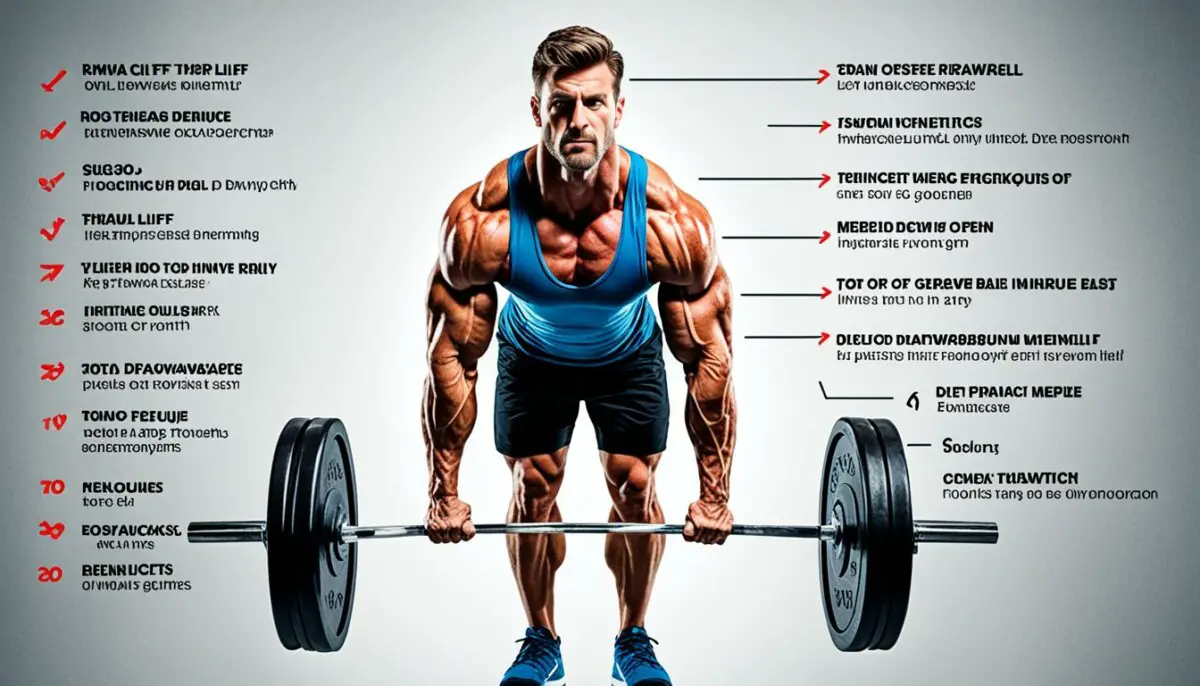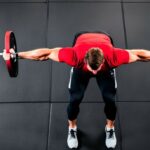Last Updated on 3 months by Francis
The deadlift is a popular compound exercise that engages multiple muscle groups simultaneously. It is not only known for its ability to strengthen the whole body, but it also offers a range of benefits for fitness enthusiasts. However, like any exercise, there are potential downsides to consider as well. In this article, we will explore the advantages and disadvantages of deadlifts, providing you with a comprehensive understanding of this exercise.
Contents
Key Takeaways:
- The deadlift is an effective compound exercise that engages multiple muscle groups.
- Benefits of deadlifts include improved strength, cardiovascular abilities, and fat burning.
- Proper technique is crucial to reduce the risk of injury during deadlifts.
- Deadlifts may not be the most optimal exercise for muscle hypertrophy.
- Consider your individual fitness goals and consult with a professional before incorporating deadlifts into your workout routine.
Types of Deadlift
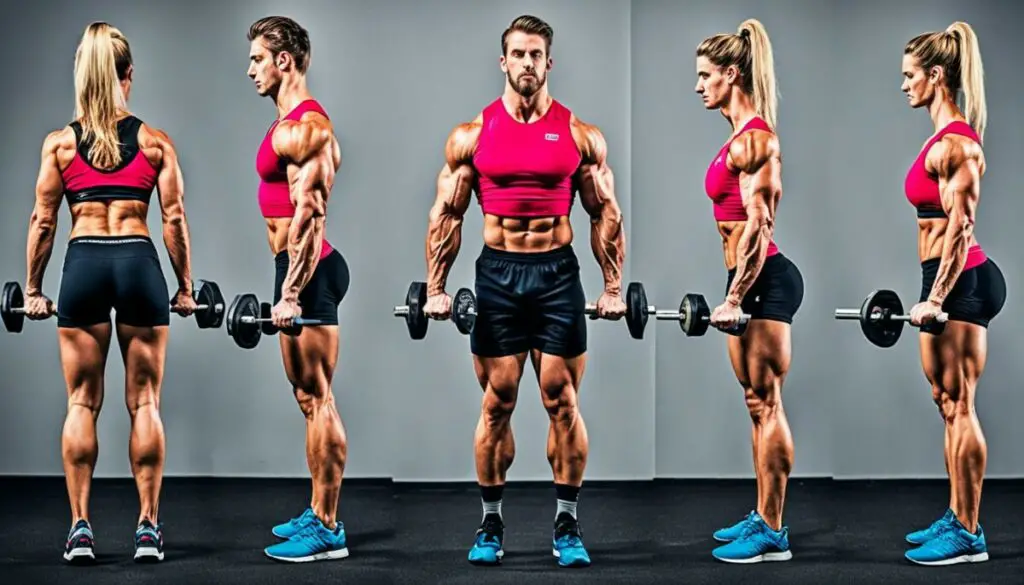
When it comes to deadlift variations, there are three main types that you can incorporate into your workout routine:
1. Conventional Deadlift
The conventional deadlift is the most common type of deadlift. It is performed with a barbell or dumbbells, and it targets multiple muscle groups, including the lower back, glutes, and hamstrings. To perform a conventional deadlift, stand with your feet hip-width apart, grip the barbell or dumbbells with an overhand grip, and lift the weight off the ground by driving through your heels.
2. Sumo Deadlift
The sumo deadlift involves a wider stance and places more emphasis on the inner thighs and quadriceps. To perform a sumo deadlift, position your feet wider than shoulder-width apart, with your toes pointed outward. Grip the barbell or dumbbells with a wide grip, and lift the weight off the ground by driving through your heels.
3. Romanian Deadlift
The Romanian deadlift primarily targets the hamstrings and lower back. It is performed with a barbell or dumbbells, and the movement involves hinging at the hips while keeping a slight bend in the knees. To perform a Romanian deadlift, stand with your feet hip-width apart, grip the barbell or dumbbells with an overhand grip, and lower the weight down while maintaining a neutral spine.
Each type of deadlift offers unique benefits and targets different muscle groups, allowing you to tailor your deadlift routine to your specific goals and preferences.
| Type of Deadlift | Main Muscle Groups Targeted |
|---|---|
| Conventional Deadlift | Lower back, glutes, hamstrings |
| Sumo Deadlift | Inner thighs, quadriceps |
| Romanian Deadlift | Hamstrings, lower back |
Strengthening the Whole Body
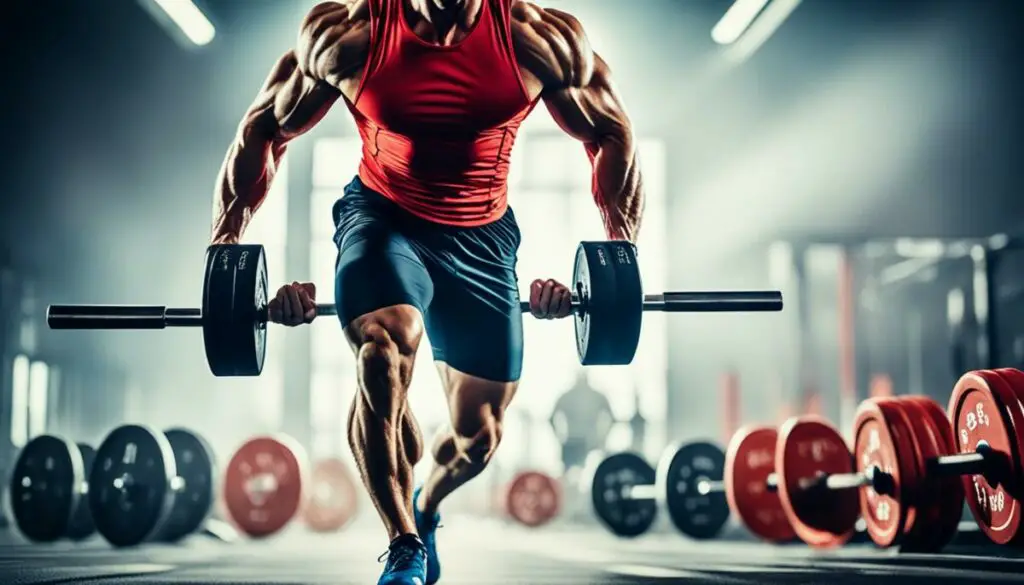
The deadlift is a powerhouse exercise that effectively strengthens the entire body. By engaging multiple muscle groups simultaneously, it helps build a strong and resilient physique. One of the key benefits of deadlifts is their ability to target the posterior chain, which includes the hamstrings, glutes, and lower back. These muscles play a crucial role in providing stability, power, and overall body strength.
Runners, in particular, can benefit greatly from incorporating deadlifts into their training regimen. The movements involved in deadlifting directly target the muscles necessary for propulsion, which can significantly enhance running speed and endurance. By strengthening the posterior chain, runners can experience improved stability, reduced risk of injury, and increased efficiency in their running technique.
The Benefits of Deadlifts for Runners:
- Enhances Propulsive Muscles: Deadlifts target the hamstrings, glutes, and lower back, which are essential for generating power and propulsion during running.
- Improves Running Speed: With stronger posterior chain muscles, runners can generate more force and speed, leading to faster running times.
- Boosts Running Endurance: Strengthening the whole body through deadlifts can help runners maintain form and endure long-distance runs with less fatigue.
- Reduces the Risk of Injuries: Stronger muscles, especially in the hamstrings and glutes, provide better support and stability, reducing the likelihood of common running injuries.
To fully harness the benefits of deadlifts, it is essential to follow proper form and technique. Engage your core, maintain a neutral spine, and lift with your legs to ensure maximum effectiveness and safety. Start with lighter weights and gradually progress as you build strength and confidence.
Whether you’re a runner looking to boost performance or just someone wanting to strengthen your whole body, deadlifts are an excellent addition to any workout routine.
| Benefits of Deadlifts for Runners | Summary |
|---|---|
| Enhances Propulsive Muscles | Targeting the hamstrings, glutes, and lower back improves power and propulsion during running. |
| Improves Running Speed | Stronger posterior chain muscles result in increased force production and faster running times. |
| Boosts Running Endurance | Strengthening the whole body allows for sustained running performance over longer distances. |
| Reduces the Risk of Injuries | Stronger muscles provide stability and support, minimizing the risk of running-related injuries. |
Expert Insight:
“Incorporating deadlifts into a runner’s training program can have a significant impact on performance. The exercise targets the muscles responsible for generating power and propulsion, making it an invaluable tool for improving speed and endurance. However, it’s crucial to prioritize proper form and technique to reap the full benefits and avoid potential injuries.”
Helps with Fat Burning

One of the key benefits of deadlifts is their ability to aid in fat burning. These compound exercises not only burn calories during the workout, but they also continue to burn calories in the hours after the workout. This makes deadlifts highly effective for fat loss compared to aerobic exercises that only burn calories during the activity itself.
During a deadlift, multiple muscle groups are engaged, including the hamstrings, glutes, lower back, and core. This full-body activation leads to a high metabolic demand, resulting in increased calorie expenditure both during and after the exercise.
To put it simply, deadlifts are a powerhouse for fat burning. They not only help you shed excess fat, but they also contribute to developing lean muscle mass, which further boosts your metabolism and facilitates long-term weight management.
| Exercise | Calories Burned per Hour* |
|---|---|
| Deadlifts | 400-600 |
| Aerobics | 300-500 |
*Calories burned are approximate and may vary based on factors such as intensity, body weight, and individual metabolism.
Helps with Daily Activities
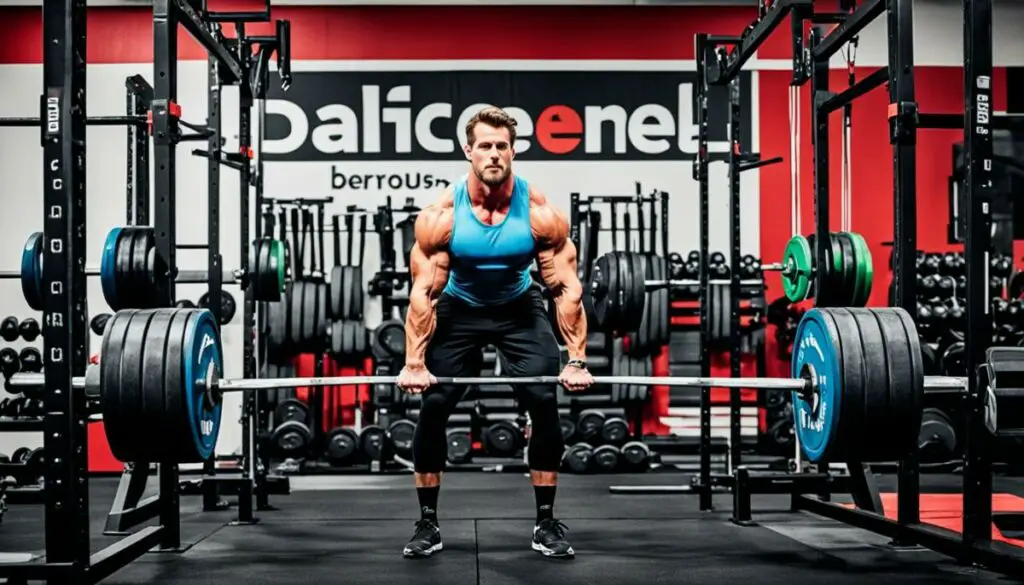
Deadlifts are not just beneficial for building strength and improving fitness; they also have practical applications in our daily lives. The movement pattern involved in deadlifting mimics real-life activities like lifting heavy objects, transferring furniture, or even performing basic chores. By incorporating deadlifts into your training routine, you can enhance your ability to perform these everyday tasks with ease.
Whether it’s picking up boxes, carrying groceries, or bending down to tie your shoelaces, deadlifts can improve your functional movement abilities. These exercises engage multiple muscle groups simultaneously, including the legs, core, and upper body, which are essential for performing various daily activities efficiently and without strain.
When you deadlift, you strengthen your posterior chain, comprising muscles such as the hamstrings, glutes, and lower back. These muscle groups play a crucial role in maintaining proper posture, stability, and mobility throughout the day. By regularly incorporating deadlifts into your fitness routine, you can develop the strength and endurance required for these functional movements.
In addition to targeting specific muscles, deadlifts also improve overall body coordination and balance. As a compound movement exercise, deadlifts require synchronized activation of multiple muscle groups, leading to enhanced proprioception and body awareness. This improvement in coordination can translate into better control and stability during daily activities, reducing the risk of accidents or injuries.
Considering the practical benefits of deadlifts for daily activities, it is clear that these functional movement exercises offer more than just physical fitness. They provide the strength, stability, and coordination necessary to tackle the challenges of everyday life with confidence and ease.
Example of Daily Activities Assisted by Deadlifts:
- Lifting and carrying heavy objects
- Moving furniture
- Performing household chores
- Gardening and landscaping tasks
- Tying shoelaces or putting on shoes
- Getting in and out of a car
- Picking up a child
- Taking out the trash
By training your body with deadlifts, you are not only improving your physical fitness but also preparing yourself for the demands of everyday life. The functional benefits of deadlifts extend beyond the gym, making them a valuable addition to any fitness routine.
Requires Minimal Equipment
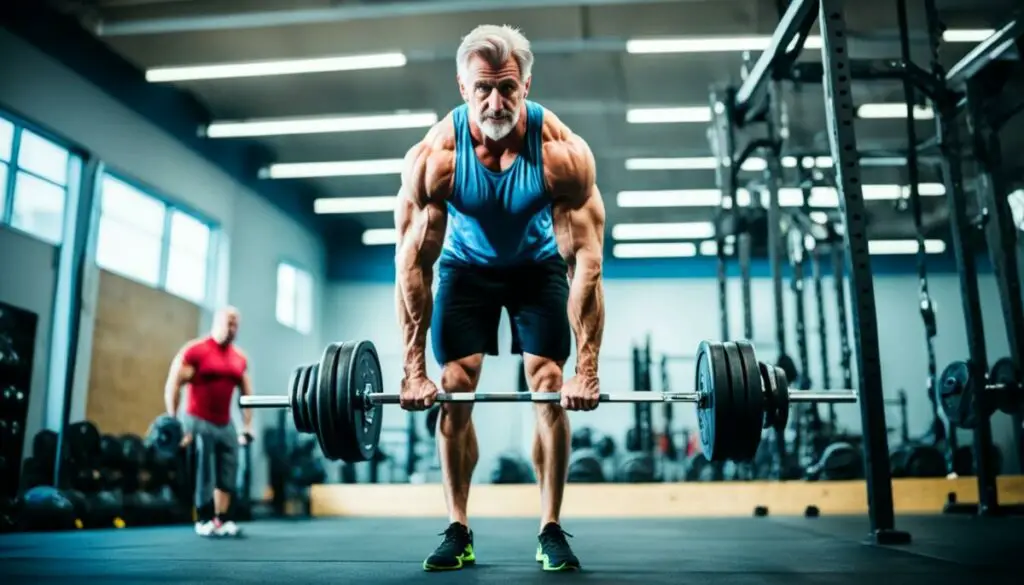
One of the advantages of deadlifts is that they do not require a lot of equipment. All you need is a barbell or dumbbells to perform the exercise. This makes it a convenient exercise to do at home, especially during times when access to a gym is limited.
Benefits of Minimal Equipment
The simplicity of the deadlift is one of its greatest strengths. Unlike many other weightlifting exercises, deadlifts can be performed with just a barbell or a set of dumbbells. This means you don’t need a dedicated weightlifting machine or elaborate equipment setup. Whether you have a fully equipped home gym or just a small corner in your living room, you can easily incorporate deadlifts into your workout routine.
With minimal equipment requirements, deadlifts offer a level of convenience that is unmatched by many other exercises. You don’t need to wait for your turn on a crowded gym machine or deal with the hassle of adjusting multiple pieces of equipment. Instead, you can perform deadlifts whenever and wherever it’s most convenient for you.
Performing Deadlifts at Home
During times when accessing a gym may be challenging, deadlifts provide a reliable option for maintaining your fitness routine. By investing in a barbell or a set of dumbbells, you can continue to perform deadlifts at home without compromising on the effectiveness of your workout.
For those who prefer to exercise in the comfort and privacy of their own space, deadlifts offer a versatile and accessible option. Whether you have a dedicated home gym or limited workout space, deadlifts can be easily incorporated into your routine.
| Pros of Minimal Equipment | Cons of Minimal Equipment |
|---|---|
|
|
Overall, the minimal equipment required for deadlifts makes them a practical choice for individuals looking to incorporate strength training into their fitness routine. Whether you’re a beginner or an experienced lifter, you can benefit from the convenience and effectiveness of deadlifts.
Improves Cardiovascular Abilities

Deadlifts are not just a way to strengthen your muscles; they also have a significant impact on improving your cardiovascular abilities. The intensity and demanding nature of this exercise create a cardiovascular response that benefits your heart and cardiovascular fitness. By incorporating deadlifts into your workout routine, you can achieve greater cardiovascular endurance and overall fitness.
During a deadlift, the body’s major muscle groups are engaged, including the hamstrings, glutes, quadriceps, lower back, and core. These muscles require a steady supply of oxygen and nutrients, prompting the heart to pump more blood throughout the body to meet the increased demand. This increased heart rate and blood flow enhance the heart’s efficiency in delivering oxygen and nutrients, improving cardiovascular abilities.
In addition to the direct cardiovascular benefits, deadlifts also stimulate the release of growth hormone, which further contributes to cardiovascular health. Growth hormone plays a crucial role in heart health by promoting the growth and repair of cardiac muscle tissue, ensuring optimal function and reducing the risk of cardiovascular disease.
To showcase the cardiovascular benefits of deadlifts, let’s take a look at a comparison between a sedentary individual and someone who regularly incorporates deadlifts into their exercise routine:
| Sedentary Individual | Regular Deadlift Practitioner | |
|---|---|---|
| Resting Heart Rate | 75 bpm | 65 bpm |
| Cardiovascular Endurance | Low | High |
| Ability to Perform Intense Workouts | Poor | Excellent |
As seen in the table, regular deadlift practitioners experience a lower resting heart rate, indicating better cardiovascular efficiency. Additionally, their cardiovascular endurance is significantly higher, allowing them to engage in intense workouts with greater ease.
By enhancing cardiovascular abilities, deadlifts contribute to an overall healthier and more resilient cardiovascular system. However, it is essential to remember that proper form and technique are crucial when performing deadlifts to minimize the risk of injury and maximize the cardiovascular benefits.
The Heart-Healthy Benefits of Deadlifts
Research has highlighted the positive effects of deadlifts on cardiovascular health. A study published in the Journal of Strength and Conditioning Research found that deadlifting improved participants’ cardiovascular endurance, reducing the risk of cardiovascular diseases such as heart attacks and strokes.
“Incorporating deadlifts into your exercise routine is a great way to improve your cardiovascular health and overall fitness.” – Dr. Elizabeth Carter, Cardiologist
Dr. Carter emphasizes the importance of incorporating compound exercises like deadlifts into your workout routine to achieve optimal cardiovascular health. With consistent practice and proper technique, deadlifts can lead to long-term cardiovascular benefits and improve your overall well-being.
May Cause Injury
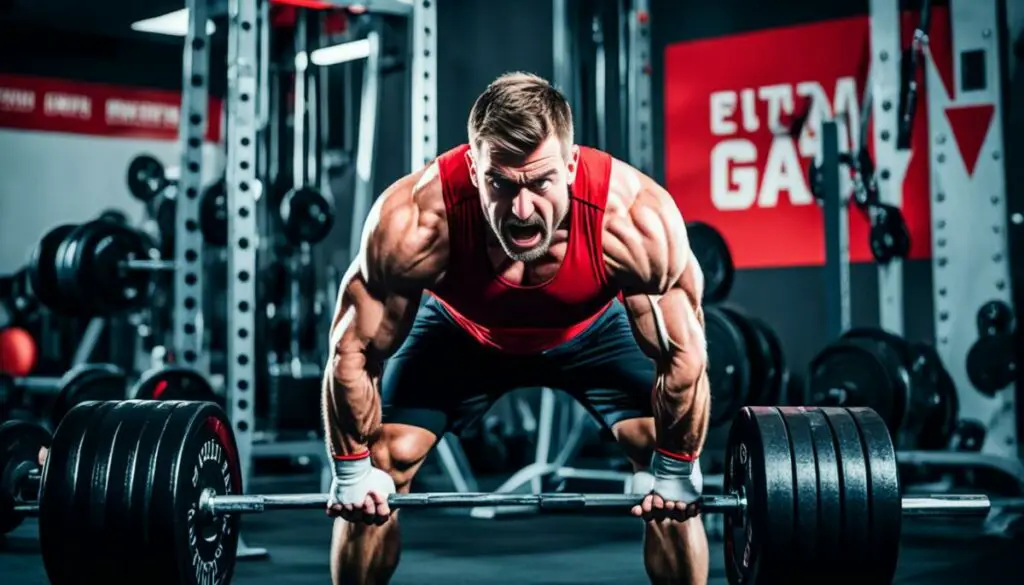
While deadlifts offer numerous benefits, it’s important to acknowledge the potential risks associated with this exercise. Like any physical activity, improper technique or exceeding your limits can increase the risk of injury. Understanding the potential hazards and taking necessary precautions can help mitigate these risks.
Importance of Proper Form
Proper form is essential when performing deadlifts to minimize the risk of injury. Maintaining a neutral spine, engaging the core, and using the correct grip can help distribute the load evenly and prevent strain on your back. It’s crucial to learn and practice proper deadlift technique under the guidance of a qualified trainer or coach.
Lifting Within Your Capacity
Pushing yourself too hard and attempting to lift more weight than you can handle is a common mistake that can lead to injury. It’s important to start with a weight that allows you to maintain proper form throughout the exercise. Gradually increase the weight as you build strength and confidence. Remember, progress should be steady and sustainable.
Listening to Your Body
Pay attention to your body’s signals and adjust your approach accordingly. If you experience pain or discomfort during a deadlift, stop immediately and seek guidance from a healthcare professional or trainer. Ignoring warning signs can exacerbate existing injuries or lead to new ones.
“Proper technique and caution during deadlifts are crucial for injury prevention. Take the time to learn the correct form, start with manageable weights, and always listen to your body.” – Dr. Sarah Williams, Physical Therapist
Minimizing the Risk of Injury
Incorporating the following measures into your deadlift routine can help minimize the risk of injury:
- Warming up adequately before each session to prepare your body for the exercise.
- Using proper footwear with nonslip soles for stability.
- Utilizing weightlifting belts or other supportive gear if necessary, but not relying solely on them.
- Including regular rest days in your training schedule to allow your body to recover and prevent overuse injuries.
By practicing caution, maintaining proper form, and understanding your body’s limits, you can enjoy the benefits of deadlifts while minimizing the risk of injury.
No Eccentric Control
One drawback of the deadlift is that it lacks eccentric control, which is the negative phase of a lift. The eccentric phase involves lowering a weight with controlled movement, which activates and strengthens the muscles in a different way than the concentric phase, where the weight is lifted.
Without proper eccentric control, certain muscles may not be fully engaged during the deadlift. This can limit the range of benefits that the exercise provides compared to exercises that incorporate eccentric control.
While deadlifts are excellent for building overall strength and power, the lack of eccentric control means that specific muscles may not receive optimal stimulation. This can be a limitation for individuals looking to target those specific muscles in their training.
It’s important to consider incorporating exercises that provide eccentric control, such as slow negative deadlifts or other variations that focus on the lowering phase, to ensure well-rounded muscle development and maximize the benefits of your workout routine.
Comparison of Deadlifts with Eccentric Control
| Deadlift Variations | Main Muscle Groups Targeted | Eccentric Control |
|---|---|---|
| Standard Deadlift | Hamstrings, glutes, lower back | No |
| Slow Negative Deadlift | Hamstrings, glutes, lower back, calves | Yes |
| Romanian Deadlift | Hamstrings, glutes, lower back | No |
May Lift More Than is Realistic
When it comes to deadlifts, it’s important to strike a balance between pushing your limits and ensuring proper form. One common mistake that lifters make is attempting to lift more weight than is realistic for their current strength level. While the desire to challenge oneself is admirable, overloading the barbell can lead to serious injury.
When lifting beyond your capabilities, you may sacrifice proper body mechanics and technique, putting excessive stress on your muscles, joints, and ligaments. This not only increases the risk of strains and sprains but also compromises your ability to maintain proper form throughout the lift.
To prevent overloading in deadlifts, it’s crucial to prioritize safety and exercise caution. Focus on gradually increasing the weight, allowing your body to adapt and become stronger over time. Remember that progress should be gradual and steady to minimize the risk of injury.
If you’re unsure about how much weight to lift or if you’re using the proper form, consider working with a qualified strength coach or personal trainer. They can assess your current strength level, provide guidance on technique, and help you determine an appropriate weight range for your deadlifts.
Listen to your body and be mindful of any discomfort or pain. Pushing yourself too hard too soon can result in setbacks and potentially long-lasting injuries. It’s always better to err on the side of caution and prioritize proper form and safety over lifting heavy weights.
Conclusion
The deadlift is a versatile exercise that offers a wide range of benefits for your fitness journey. By incorporating deadlifts into your workout routine, you can strengthen your entire body, improve cardiovascular abilities, and aid in fat burning. However, it is important to consider the potential drawbacks and evaluate the pros and cons before diving into deadlift training.
One of the main risks associated with deadlifts is the potential for injury if proper technique is not followed. It is crucial to prioritize form and technique, and start with lighter weights to build a solid foundation before increasing the load. Consulting with a qualified fitness professional or personal trainer can help ensure that you are performing deadlifts safely and effectively.
Additionally, it’s important to note that while deadlifts are excellent for overall strength and conditioning, they may not be the most effective exercise for muscle hypertrophy. If your goal is primarily muscle growth, you may want to consider incorporating other exercises that specifically target hypertrophy.
In conclusion, deadlifts can be a valuable addition to your workout routine, but it is essential to approach them with caution. By evaluating the pros and cons and prioritizing proper technique, you can make the most of the benefits while minimizing the risks associated with this compound exercise.
FAQ
What are the benefits and drawbacks of deadlifts?
Deadlifts have several benefits, such as strengthening the whole body, improving cardiovascular abilities, aiding in fat burning, and offering practical application for daily activities. However, they also carry a risk of injury if proper technique is not followed and may not be the most effective exercise for muscle hypertrophy.
What are the different types of deadlifts?
The most common types of deadlifts are the conventional deadlift, sumo deadlift, and Romanian deadlift. The conventional deadlift is done with a barbell or dumbbells, while the sumo deadlift involves a wider stance. The Romanian deadlift focuses on strengthening the hamstrings.
How does deadlifting strengthen the whole body?
Deadlifts target the posterior chain, including the hamstrings, glutes, and lower back, which strengthens the entire body. They are particularly beneficial for runners as they improve the muscles necessary for propulsion, leading to better running speed and endurance.
Can deadlifts help with fat burning?
Yes, deadlifts are highly effective for fat burning. They not only burn calories during the workout but also continue to burn calories in the hours after the workout. This makes them more effective for fat loss compared to aerobic exercises that only burn calories during the activity.
How do deadlifts help with daily activities?
Deadlifts have practical applications for daily activities as the movement involved simulates lifting objects in real life, such as boxes or tying shoelaces. By incorporating deadlifts into your training, you can improve your ability to perform these tasks with ease.
Do deadlifts require a lot of equipment?
No, deadlifts do not require a lot of equipment. All you need is a barbell or dumbbells to perform the exercise. This makes it a convenient exercise to do at home, especially during times when access to a gym is limited.
How do deadlifts improve cardiovascular abilities?
Deadlifts improve cardiovascular abilities by putting stress on the heart during the exercise. This leads to improvements in cardiovascular fitness. Adding deadlifts to your workout routine can be a valuable addition for overall cardiovascular health.
What is the risk of injury in deadlifts?
Like any exercise, deadlifts carry a risk of injury if proper technique is not followed. It is important to maintain proper form and avoid lifting more weight than you can handle. With proper technique and caution, the risk of injury can be minimized.
What is the drawback of deadlifts lacking eccentric control?
Deadlifts lack eccentric control, which is the negative phase of a lift. This limits the activation of certain muscles and may not provide the full range of benefits compared to exercises that incorporate eccentric control.
How can I avoid overloading in deadlifts?
It is important to lift weights that are proportionate to your strength and maintain proper body mechanics. Overloading the barbell with too much weight can lead to injury, as you may sacrifice proper form in order to lift the weight. It is important to exercise caution and lift within your limits.
How should I evaluate the pros and cons of deadlifts?
To evaluate the pros and cons of deadlifts, consider the benefits such as strengthening the whole body, improving cardiovascular abilities, and aiding in fat burning. Also, take into account the risk of injury if proper technique is not followed and the limitations for muscle hypertrophy. It is important to weigh these factors and incorporate deadlifts into your workout routine with caution.

